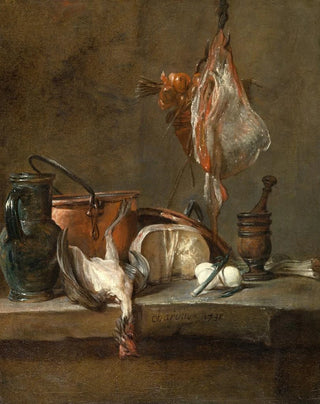Art print | Still life with a ray and a basket of onions - Jean Siméon Chardin


View from behind

Frame (optional)
In the world of painting, some works stand out for their ability to capture the very essence of everyday life while transcending mere realism. "Nature morte avec une raie et un panier d'oignons" by Jean Siméon Chardin is one of those creations that invites viewers to contemplate the beauty of ordinary objects. This piece, created in the 18th century, demonstrates Chardin's skill in transforming ordinary elements into a harmonious and poetic composition. The ray, with its organic shapes and delicate colors, rises above a basket of onions, creating a dialogue between nature and artifice, between life and death. Through this art print, Chardin encourages us to reflect on life's fleeting nature and the ephemeral beauty of things.
Style and uniqueness of the work
Chardin's technical mastery is evident in every detail of this art print. His subtly nuanced palette plays with shadows and light to bring texture to the objects. The ray, painted with striking realism, seems to almost vibrate before our eyes, while the onions, with warm, earthy tones, add a tactile dimension to the composition. The artist excels in the art of composition, arranging the elements to create perfect visual balance. Each object is carefully placed, ensuring harmony that draws the eye and invites exploration. Chardin, by choosing modest subjects, elevates the everyday to a level of grandeur, transforming a simple art print into a reflection on the beauty and simplicity of life.
The artist and his influence
Jean Siméon Chardin, an emblematic figure of the Rococo movement, left his mark on his era with his unique vision of the art print. Raised in a modest environment, he developed a passion for art from a young age that would lead him to become one of the masters of French painting. Chardin distinguished himself through his intimate approach, his ability to infuse soul into inanimate objects, and to evoke deep emotions through simple compositions. His influence extends far beyond his time, inspiring

Matte finish

View from behind

Frame (optional)
In the world of painting, some works stand out for their ability to capture the very essence of everyday life while transcending mere realism. "Nature morte avec une raie et un panier d'oignons" by Jean Siméon Chardin is one of those creations that invites viewers to contemplate the beauty of ordinary objects. This piece, created in the 18th century, demonstrates Chardin's skill in transforming ordinary elements into a harmonious and poetic composition. The ray, with its organic shapes and delicate colors, rises above a basket of onions, creating a dialogue between nature and artifice, between life and death. Through this art print, Chardin encourages us to reflect on life's fleeting nature and the ephemeral beauty of things.
Style and uniqueness of the work
Chardin's technical mastery is evident in every detail of this art print. His subtly nuanced palette plays with shadows and light to bring texture to the objects. The ray, painted with striking realism, seems to almost vibrate before our eyes, while the onions, with warm, earthy tones, add a tactile dimension to the composition. The artist excels in the art of composition, arranging the elements to create perfect visual balance. Each object is carefully placed, ensuring harmony that draws the eye and invites exploration. Chardin, by choosing modest subjects, elevates the everyday to a level of grandeur, transforming a simple art print into a reflection on the beauty and simplicity of life.
The artist and his influence
Jean Siméon Chardin, an emblematic figure of the Rococo movement, left his mark on his era with his unique vision of the art print. Raised in a modest environment, he developed a passion for art from a young age that would lead him to become one of the masters of French painting. Chardin distinguished himself through his intimate approach, his ability to infuse soul into inanimate objects, and to evoke deep emotions through simple compositions. His influence extends far beyond his time, inspiring






